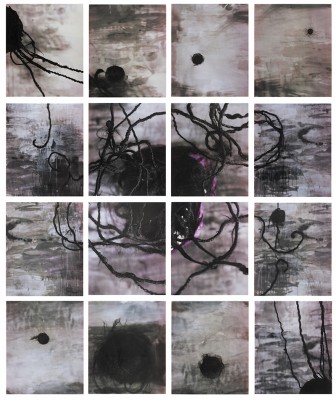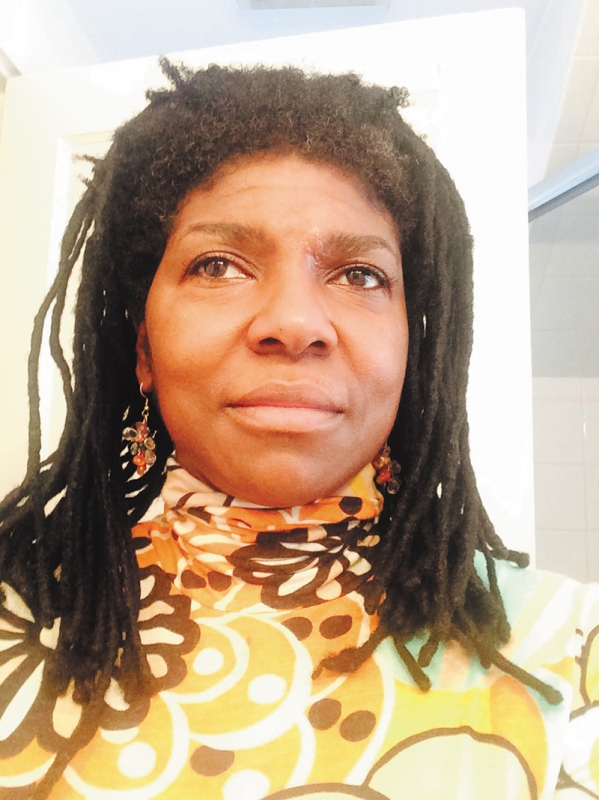Kicking & Dancing: The Political/Poetical María Magdalena Campos-Pons
Art
In a word, Our America: The Latino Presence in American Art is ambitious. This Smithsonian exhibition—now at the Utah Museum of Fine Arts (UMFA)—features over 60 Latin@ artists’ expressions and confrontations of their identities. It seeks to reframe history, embrace new scholarship and defy categories. After all, the term Latin@—which is used to include both “Latina” and “Latino”—embodies multitudes. It is constantly renegotiated and reinvented because it covers a diverse array of histories and cultures. Our America features works by well-known, standout Latin@ artists, which includes a motley chandelier by Pepón Osorio, Ana Mendieta’s signature feminist land art, Enrique Chagoya’s tongue-in-cheek twist on a Maya codex and María Magdalena Campos-Pons’ Polaroid photographs.
The exhibition also, however, makes a marked point to showcase artists that were excluded from the American art canon and erased from enduring concepts about American culture. “The Smithsonian recognized that the museum should be a place where all Americans see themselves reflected in great art, but the Latino experience was missing,” says Whitney Tassie, Curator of Modern and Contemporary Art at UMFA. “Our America presents a picture of an evolving national culture that challenges expectations of what is American and what is Latino.” Our America, then, is situated from the 1950s—when the Latin@ community began to self-identify with the term “Latino art”—to the present. “[Utah] continues to evolve, to diversify and to grow,” says Gretchen Dietrich, Executive Director of the UMFA. “This is an important conversation—a look at Latino identity—to bring to our community.”

In tandem with the exhibition, Campos-Pons will deliver an artist talk at UMFA. She is an artist of interdisciplinary processes—painting, sculpture, photography, body art, installation, performance—and intertwined identities: woman, Cuban, black, American, Latina, artist. Fitting for an artist featured in Our America, Campos-Pons’ recent works have examined art’s social impact. At the Venice Biennale, Campos-Pons was the first woman of black diaspora to perform at the Piazza San Marco. At the Havana Biennial, she and her husband, Neil Leonard, brought together several Cubans and Americans to bake bread together. The bread was distributed during their performance, indicating a spirit of communication between Cuba and the U.S. “Campos-Pons’ identity is often inseparable from her art,” says Tassie. “That [Campos-Pons] is included in Our America when she is largely associated with the African diaspora really shines new light on her work and illuminates the diversity within Latino art.”
For Campos-Pons, Our America is important for a community that is often “undefined and without context,” she says. Latino Americans are “like the universe,” Campos-Pons says. “Look at how many galaxies, how many stars, came out of [the Big Bang]. The idiosyncratic physical and cultural makeup of the Latino people—their identity—is like that: a mix of many things that become one.”
Incidentally, Campos-Pons’ work in Our America is Constellation, an enormous grid of 16 large-format Polaroids. Her dreadlocked hair, an oft-maligned indicator of African heritage, drifts through the dreamscapes of the piece. Constellation hearkens back to Campos-Pons’ painting background, but also incorporates performance and multimedia. The piece is abstract yet precise. The jumbled nest of hair in the center resembles the home of migrating birds, reminiscent of motherhood. The visual disjointedness of separate frames alludes to diaspora: Campos-Pons’ own migration from Cuba 27 years ago and the displacement of Africans through slavery. Like a constellation in the sky, we see the whole composition, but also its individual parts.
“The stars, when they die, still flicker in the sky,” says Campos-Pons. “We see the light of a star that has gone. That is in this piece—the permanence of things that are no more.” It’s clear that Constellation is intensely personal. Campos-Pons uses personal memory to formulate an evocative and lyrical landscape. “I think of my mother. I think of Cuba,” she says. But—and as is true throughout Our America—there’s a sense of duality. Constellation is also a striking tribute to cultural resilience. In Campos-Pons’ own words, “It’s political-poetical.”
“[Constellation] is about this energy that is intangible—that a star can still be luminous, reachable, when it dies,” Campos-Pons says. Her work is meant to transcend the divides between generations and cultures. “How do you translate something so vast into something accessible?” The same question pervades throughout Our America. As we observe Latin@ artists who helped shape the artistic movements of American culture, we see that their works frequently display entirely new forms that challenge and recalibrate. How might one exhibition begin to rewrite American art history to incorporate that silent Latin@ majority, to celebrate cultural identity and ignite dialogue?
“I am a Latina artist; I am a black artist; I am a Cuban artist. I am an artist,” says Campos-Pons. “I am still kicking and dancing. I have freedom to be lost, to be honest, to contradict myself—my life’s poetry.” Like the landscape of American art, Campos-Pons is constantly growing, evolving and pushing boundaries. In Our America, Constellation pulls at us plaintively, palpably, through personal memory, the interconnectedness of experience and the inherent richness of identity.
Our America will be on exhibition at the UMFA through May 17. The show includes both English and Spanish texts. María Magdalena Campos-Pons’ artist talk is April 10 at 5 p.m. and free of charge for admission. For more information, visit umfa.utah.edu.



